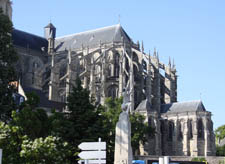Le Mans (Sarthe, France) - Cathedral of Saint-Julien
- Disclaimer
The dating found here is based on the work of John James, and is meant on this site to serve as a starting point. James' dating is derived from a system that uses his interpretation of the development of capitals over time as the basis for chronology, among other factors. His goal is to refine the dating to within years rather than decades. I have not fully embraced James' methodology, and will be developing this page from its current state to one which is admittedly more conservative. The relative expenditure values found in the Timeline are also based on James' work, and I believe these to be reasonably reliable. They are intended only to give a sense of the amount of work involved in each decade.
I have added the idea of the "project" as a way of separating work in buildings. In my mind, a "project" is a discrete section of work in a building that resulted from the one-time acquisition of funding. "Projects" are generally separated by at least a decade where no work was being done. It is my view that it would have been unwise to start a "project" that could not be finished and protected from the elements, and as such a "project" usually involved a wing or multiple wings of a building, from floor to roof. Rural churches, which could only secure small amounts of funding at irregular intervals, often were the result of many small projects, while the great churches, which benefitted from relatively consistent funding, may have involved only a few large projects.
I have added the idea of the "project" as a way of separating work in buildings. In my mind, a "project" is a discrete section of work in a building that resulted from the one-time acquisition of funding. "Projects" are generally separated by at least a decade where no work was being done. It is my view that it would have been unwise to start a "project" that could not be finished and protected from the elements, and as such a "project" usually involved a wing or multiple wings of a building, from floor to roof. Rural churches, which could only secure small amounts of funding at irregular intervals, often were the result of many small projects, while the great churches, which benefitted from relatively consistent funding, may have involved only a few large projects.
- Timeline with Relative Expenditure (if available, in building units)
 |
 |
 |
- Project A - 1100s - Phase 1 - nave walls
Nave walls
- Project B - 1130s - Phase 2 - south portal
- Project B - 1130s - Phase 3 - south porch
South porch
- Project B - 1130s - Phase 4 - nave piers 1-4
Nave piers 1-4
- Project B - 1130s - Phase 5 - nave piers 5-
Nave piers to the west
- Project B - 1130s - Phase 6 - nave (t)
Nave triforium
- Project C - 1140s - Phase 7 - nave w(c)
Nave clerestory, western bays
- Project C - 1140s - Phase 8 - nave e(c)
Nave clerestory, eastern bays
- Primary Sources for Dating
1134, 3 September - MANS
Fire destroyed the works
Fire destroyed the works
In the year of Our lord 1134, the 14th moon, 3rd of the nones of September, the eight year of the ordination of Guy…the entire city of Le Mans, with all of the churches that were within the walls perished in ashes…
1217, November - MANS
Permission to build across town walls
Permission to build across town walls
They wanted to enlarge their church, whereas to enlarge the church the walls of the city would be breached next to the palace of the bishop of Le Mans, if it pleases you and causes you no financial hinderance. We also concede to said canons the removal of dirt and even the wooden palisade pertaining to the aforementioned church, along the length of the canon's cloister, and permit them to have their gardens inside the cloister, as they have formerly been accustomed to having; as the enclosure around said embankment is not defensible.
